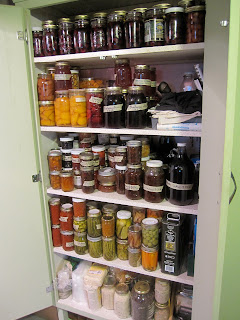 This week I stayed motivated to continue putting the garden and yard to sleep for the year. I planted garlic and further trained my espalier apple trees on Monday. I was inspired by the espalier apple trees I saw at the Chicago Botanic Garden a few years ago. The next season, I planted two dwarf apple varieties along our north fence; the second season they produced a good amount of fruit. This year there wasn't any, probably because I pruned them vigorously last spring. Our neighbor, who guides my trimming activities, showed me a couple of tricks to help train the flexible young branches. One is to clip a clothespin to the skinny trunk just above and parallel to a branch you want to bend so that it pushes it downward. That technique worked very well. This week I pursued the second technique of hanging a weight on the end of the branch to pull it down. After this season there were many vertical branches I would have liked to clip off, but I've learned that spring is the best time to prune because the trees are least disease-prone. So for now I trained the new growth. We'll see what we need to prune in the spring (Am I thinking of next season already? You bet!) I also began breaking down my pole bean trellis and pulling dead stems off of perennials. I haven't touched a rake yet, but plan to this weekend. Otherwise it wouldn't be the first time I miss the city's leaf collection. I do try to keep as many leaves as possible on our property to use as winter mulch, but our compost bin can't hold the rest.
This week I stayed motivated to continue putting the garden and yard to sleep for the year. I planted garlic and further trained my espalier apple trees on Monday. I was inspired by the espalier apple trees I saw at the Chicago Botanic Garden a few years ago. The next season, I planted two dwarf apple varieties along our north fence; the second season they produced a good amount of fruit. This year there wasn't any, probably because I pruned them vigorously last spring. Our neighbor, who guides my trimming activities, showed me a couple of tricks to help train the flexible young branches. One is to clip a clothespin to the skinny trunk just above and parallel to a branch you want to bend so that it pushes it downward. That technique worked very well. This week I pursued the second technique of hanging a weight on the end of the branch to pull it down. After this season there were many vertical branches I would have liked to clip off, but I've learned that spring is the best time to prune because the trees are least disease-prone. So for now I trained the new growth. We'll see what we need to prune in the spring (Am I thinking of next season already? You bet!) I also began breaking down my pole bean trellis and pulling dead stems off of perennials. I haven't touched a rake yet, but plan to this weekend. Otherwise it wouldn't be the first time I miss the city's leaf collection. I do try to keep as many leaves as possible on our property to use as winter mulch, but our compost bin can't hold the rest.  |
| Yellow Plastic "Lame" |
After harvesting all my beets on Sunday I had a lot of beet greens with which to contend. I never like to waste them, but blanching and freezing them all can be tedious and sometimes I don't feel I can even use them all before the next season. So Monday I found a way to use a lot (like a pound) of them very quickly. I served this with vegetable crudites and my freshly baked bread as a sort of "nosh plate" dinner, which we occasionally do--it makes for a nice communal meal. I used golden beet greens which imparted a beautiful yellow cast to the dish--almost looked like I'd added curry, or at least turmeric. And I didn't have bacon on hand though I had a container of bacon fat--a staple in the back of our fridge, it can always be found snuggled up next to the everlasting container of hog casings (sausage-making season is upon us.)
Creamy Beet Green Dip
Makes 12-14 1/4-cup servings
I adapted this recipe from one that called for collard greens. You could really use any leafy greens from spinach to kale.

2 slices bacon (can sub./add finely diced, skinned bratwurst)
Bacon fat (if not using bacon)
1 small onion, chopped (about 1 c.)
1 medium red bell pepper, seeded and chopped (3/4 c.)
1 lb. fresh beet greens/other greens, washed, stems removed, chopped in a food processor (or by hand)
3 cloves garlic, minced
1 8-oz. pkg. cream cheese, cubed and softened (can sub. 1/2 the amount with plain whole milk yogurt)
2 oz. shredded cheese (about 1/2 c.)--Monterey Jack, cheddar, gouda, etc.
1/2 c. sour cream
1/2 t. Cajun seasoning (optional)--if you don't use this, add 1/4 t. salt
Breadsticks, vegetable crudites, fresh bread, crostini for dipping
Preheat oven to 350 degrees. In a 12-inch skillet cook bacon until crisp. Drain bacon on paper towel. Remove and discard all but 2 t. bacon drippings from skillet. Add onion and peppers to skillet. Cook 5 min. over medium heat or until vegetables are just tender, stirring occasionally. Add greens and garlic; cover and cook 10 min. or until tender, stirring occasionally. Remove from heat. Add cream cheese, shredded cheese, sour cream, and Cajun seasoning (or salt) to greens mixture, stirring until combined. Crumble bacon and add to greens mixture (or add bratwurst, if subbing.) Spread mixture in a 1 1/2-qt. casserole dish or 9-inch pie plate. Bake, uncovered, 10 min. or until warmed through. Serve with vegetable dippers or bread(sticks).
 |
| Free Pears! |
 |
| Vintage Martin-family fabrics |







































